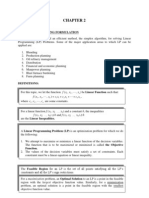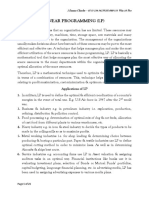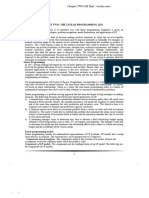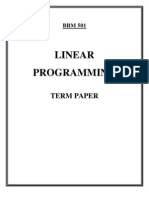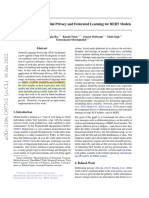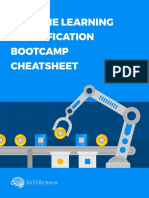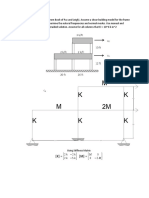Linear Programming and Lean Manufacturing
Uploaded by
Lau YeowhongLinear Programming and Lean Manufacturing
Uploaded by
Lau YeowhongJournalofServiceScienceandManagement,2015,8,8591
PublishedOnlineFebruary2015inSciRes.http://www.scirp.org/journal/jssm
http://dx.doi.org/10.4236/jssm.2015.81010
Discourse about Linear Programming and
Lean Manufacturing: Two Different
Approaches with a Similar,
Converging Rational*
Bruno G. Rttimann
InspireAG/ETHZurich,Zurich,Switzerland
Email:brunoruettimann@bluewin.ch,ruettimannbrunog@ethz.ch
Received19January2015;accepted3February2015;published6February2015
Copyright2015byauthorandScientificResearchPublishingInc.
ThisworkislicensedundertheCreativeCommonsAttributionInternationalLicense(CCBY).
http://creativecommons.org/licenses/by/4.0/
Abstract
In recent years, the Toyota Production System has also assumed in western manufacturing plants
a predominant position. Lean Manufacturing, as it is usually called in the occidental world, aims at
a Singlepieceflow job handling and has its advantages compared to the classic Batch and Queue
job handling. On the other hand, mathematical Linear Programming optimization techniques have
passed into oblivion, having obtained the feel to be inappropriate for production planning. Al
though the two approaches have different aims and application, they give particular attention to
scarce resources. The concepts of bottleneck in Lean Manufacturing and shadow price in Lin
ear Programming are complementary. The paper shows the different focus of the two approaches
and crystallizes their synergic values.
Keywords
Linear Programming, Lean Manufacturing, Shadow Price, Bottleneck
1. Introduction
In the seventies and eighties Operations Research (OR), the branch of mathematics dealing with optimization
problems, became very popular. Within the multiple classes of problems, especially those problems characterized by one objective in a deterministic environment and linear equations, solvable with Linear Programming
(LP) and its Simplex algorithm, it found selective application in industry. Increasing computational power
helped to spread the technique into the offices of multinational enterprises. But it encountered the same destiny
*
This paper is based on reference [1].
Howtocitethispaper:Rttimann,B.G.(2015)DiscourseaboutLinearProgrammingandLeanManufacturing:TwoDiffer
entApproacheswithaSimilar,ConvergingRational.JournalofServiceScienceandManagement,8,8591.
http://dx.doi.org/10.4236/jssm.2015.81010
B. G. Rttimann
as cybernetics in the sixtiesit lost attractiveness. In fact, lack of realistic practicability prevailed over the illusion of being able to optimize socio-economic systems with the computer. Since the nineties, after the spreading
of the Toyota Production System (TPS) in America and Europe, which became popular with the name of Lean
Manufacturing (LM), production has put the emphasis rather on cost savings and waste reduction (Muda) and
continuous improvement (Kaizen) than on overall margin optimization. Indeed, modern production planning
systems have other, more practical optimization functions than the valid but theoretical maximizing margin contribution approach. In fact, the production mix cannot always be changed in the short term and is usually given
by the customer base, especially if production is made to order. LP suffered the reputation of being too academic, although the basic concepts retain its validity and have its proven field of application, such as e.g. in
transportation. Nevertheless, LP optimization of production and LM organization of work put the same attention
to scarce resources of production, resources becoming the bottleneck of production, which makes it worth to
compare the two approaches. In the following, we will analyze the peculiarities of each approach and show the
dichotomic characteristics of both optimization techniques.
2. Linear Programming Aiming at Overall Optimization
What is the classic problem statement of an LP optimization problem for a plant manager? Given is a manufacturing plant with m machines, with each machine having a capacity of bm. With these machines, n products with
the quantity xn are manufactured. The specific occupancy load of the m resources with the n products is given by
the matrix A of dimension [mn]. Every product generates its specific margin contribution cn. The aim is to identify the optimal product mix x*, i.e. the quantity of each single product to be produced, which maximizes the
overall margin contribution complying with the resource restrictions. The problem solved by LP is often also
called Linear Optimization. The problem can be written in mathematical terms represented by the standard
form
max z cT x Ax b, x 0
(1)
where the restrictions, given by the machine capacities, have been added with the non-negativity requirements of
production volume of the optimization variables xn. The resulting overall margin contribution of the maximizing
function z is a scalar product, given by the transposed vector cT of specific margin contribution coefficients and
the vector of the product mix x. The mathematical problem has also a geometric interpretation as represented in
Figure 1 showing the plane geometry case of two products and three machines.
LP is a special case of convex optimization which can be solved via the Simplex algorithm presented first by
Dantzig, a numeric solving technique well explained in scholastic literature, which we will not deal with here.
The number of basic solutions are
n m
m
(2)
The number of feasible basic solutions, which is smaller than calculated by (2), are given by the domain of
definition, represented through the polyhedron delimited by the intersecting linear restrictions, i.e. the straight
lines g1, g2, g3, and the two x-axes. The number of feasible basic solutions of the Simplex algorithm are given by
the corners of the convex polygon of which one is the optimal basic solution x* maximizing the objective function. To solve the system of linear equations, slack variables ym are introduced to transform inequality restrictions into easy solvable equations.
Each primal problem has associated a dual problem (3), where capacities are switched with the coefficients of
the objective function; the primal slack variables become the optimizing variables of the dual LP problem.
min bT y AT y c, y 0
(3)
In the case of n < m it may be useful to solve the dual problem of the slack variables instead of the primal
problem to shorten the number of iterations, given the fact that the primal solution can also be seen in the dual
Simplex table. The interpretation of the slack variables in a production problem of LP is unused resource, i.e.
spare production capacity of the resource where the slack variables have a positive value other than zero. This
represents the shadow price of the resource in the dual problem. If a slack variable is zero, the shadow price of
this resource is zero. In economics the shadow price corresponds to the opportunity cost of the alternative use of
the resource, i.e. selling the resource instead of using it for production.
86
x2
B. G. Rttimann
g2
30
Optimierungsgradient
x cT x
20
z max cT x
10
g3
x2
Optimaler Mix x*
Zulssiger
Definitionsbereich
10
g1
x1
20
30
40
x1
Figure 1. Geometric solution to an LP problem with two products x1 and x2.
Key questions of LP are related to sensitivity and post-optimality. Sensitivity is the analysis of the effects on
the objective function z by varying the input parameters Amn, bm, and cn (4). Geometrically interpreted, changing
the bm corresponds to shifting parallel the straight line of the resources, whereas changing the cn corresponds to
change the slope of the objective function.
z
Amn , bm , cn
(4)
Post-optimality (5) analyses the stability of the optimal basic solution x*, i.e. within which interval the input variables can vary without changing the validity, i.e. the composition of the optimal basic solution.
x: x ; A
*
mn
, bm , cn
(5)
This represents, without going into detail, some questions related to LP problems in a production environment.
This simplified formulation of LP problems does not take explicitly into consideration, e.g., size of production
batches or the problem of change-over, complications which can approximately be solved by reducing the capacity of the resources bm or more exact by passing to another class of optimization problems, being solvable
with general Mathematical Programming.
In the case of non-linear problems, an objective function expanded by the restrictions with Lagrange multiplier can be used. For concomitant application of multi objective functions, Pareto optimality is applied. A
multi- objective solution is said to be Pareto efficient when any change of improvement for one objective function is done to the detriment of another objective function.
3. Lean Manufacturing Aiming at Local Optimization
Let us have a look at what is the LM problem statement for a plant manager. Given is the situation that several
customers require the even supply over time (i.e. a constant supply rate) of different products of a certain quantity per year, resulting in a given takt rate (TR). Apart of the elimination of waste (Muda) in the process and the
continuous improvement philosophy, the aim of LM is to implement a customer-pull takted single-piece-flow
(SPF) what we can synthesize with formula (6) and to satisfy the on-time-delivery (OTD) to customers. This is
called a just-in-time (JIT) production. Thereby it does not matter if production is made to stock (more suitable
for standard products) or made to order (more applicable for customized products). We can define JIT mathematically as
JIT lim pull n (6)
n 1
i.e. a pull-production, where handled quantities n tend to one (single-piece-flow). Please note, that the SPF applies to the handled quantity, not necessarily to the size of the production batch, which has also to match with
technical restrictions. JIT means producing and supplying the right material, in the right quantity, at the right
time, to the right place. A lean-optimized production cell represents JIT in its perfection.
To implement JIT production, manufacturing cells are conceived. Instead of grouping similar technologies
into the same workshop according to western production philosophy, the necessary equipment and machines to
manufacture similar products are displayed in-line into a U-shaped production cell; in this discourse we will use
the term manufacturing and production indifferently. The manufacturing cell is a product-optimized transfer-line
87
B. G. Rttimann
fabrication, with all necessary resources. If a cell is dedicated to one product we talk about mono product cell,
otherwise mixed product cell. A cell is characterized either by its cycle time (CT) at the bottleneck (or the workstation turnover time WTT of the bottleneck in a mixed product cell), or its inverse value which is the throughput, also called exit rate (ER) or completion rate, where CT should not be confused with the process lead time
(PLT) of the whole cell.
A customer-pull takted SPF requires that all cycle times CTij of the operations i in a cell j are equal (no Mura),
this is called a balanced line, i.e.
i:CTij CTi 1 j
(7)
whereas the cycle times of different cells j and k may differ
CTij CTik (8)
The necessity may exist to link different cells. When the cells have different cycle times (8), Kanban supermarkets are interposed between cells to decouple the cells. This allows the different cells to optimize their production without being influenced by other cell scheduling, each cell becomes a self-controlled production unit.
Within LM, theory of constraints (TOC) represents a central focus in cell-design. Restriction in production
capacity of a cell, or more generally of a production plant, is given by the throughput, i.e. the exit rate ER of the
considered manufacturing unit. The operation with the lowest ER (9) is the bottleneck of the production line.
ERi ERBottleneck
(9)
Therefore, in LM most attention is put on the bottleneck, because this limits directly the profitability of the
production unit. Within the JIT philosophy the bottleneck receives an additional aspect: it also usually represents
the controlling element of the cell, the drum complying with the production takt required by the customers
takt rate (TR). Indeed, it has to result
ER TR
(10)
i.e., the ER of the cell has to be bigger than the TR required by the customer, otherwise the cell would not be
able to satisfy customers demand. The inverse value of the TR is takt time (TT) and (10) becomes
(11)
CT TT
The dimension of time (11) in cell-design is usually preferred over the dimension throughput (10), because to
balance each operation of a cell (7), the work content is usually expressed in time units (seconds or minutes) and
will be used to optimize the work distribution within the cell. When performing a TOC analysis, a Time-Operation chart as represented in Figure 2 is a suitable tool to reveal visually process steps with cycle times that are
longer than takt time; these operations are called constraints. The process step with the longest cycle time is the
bottleneck. Please note, there may exist several constraints but every process has only one bottleneck.
To conclude, in the LM approach the triggering of the production at the drum of the line is done by downstream customers Kanban. To guarantee the perfect operation of the manufacturing line, the Drum-BufferRope technique is usually used, i.e. the drum has always to work assured by a full buffer and the upstream operations are triggered by the rope via Kanban.
Cycle Time CT
Process constraints
Bottleneck
Takt Time TT
Figure 2. Time-operation chart of a manufacturing cell.
88
Process step
(operation)
B. G. Rttimann
4. Synthesis of both Approaches
As we notice, the problem statements in the cases of LP and LM are slightly different. For LP: given scarce resources to produce products, what would be the optimal product mix to maximize the margin contribution objective function; this represents a problem aiming at maximizing effectiveness of transformation in a production
plant. For LM: given a product mix, how to manufacture it in an optimal way; this represents a problem aiming
at maximizing efficiency of transformation. After having exposed both approaches, let us elucidate the following emerging insights:
First: LP starts from the available resources bm, usually expressed in time units, and asks what can be produced x* to maximize a target function z such as (1), typically an economics (theoretic) approach of overall optimization. LM starts from a given mix x and asks how to produce it efficiently, a question of coefficient matrix
A, i.e. [amn], expressed in time per piece, typically a production (practical) approach of local optimization.
LP
LM
JIT lim pullx(n)
n1
ERBottleneck TRCustomer
max z c T x Ax b, x 0
i.e.m, n :
amn TTCustomer
(12)
PLTCell EDTCustomer
In other words: LP maximizes a single objective function z considering several restrictions regarding resources bm and tries to identify the optimal product mix x*, which maximizes the target function. LM tries to satisfy several customer requirements, such as takt rate TR and expected delivery time EDT, i.e. the mix is given,
and tries to optimize the parameters of a multi objective equation system (12), which allows JIT supply. Nevertheless, both are problems of solution existence.
Second: In the LP problem, the bottleneck is given by the resource with the lowest residual machine capacity
bm with the optimal mix; the resources are expressed e.g. in hours or days, which is an aggregated figure. In LM
the bottleneck is defined by the largest coefficient amn of the matrix A, a specific value, e.g. minutes/piece (13).
LP
LM
bbottleneck : inf bm x x *
Abottleneck : supamn
(13)
inf bm lim n supamn xn (14)
n 1
inf bm n supamn xn
m
(15)
In other words: Both problem statements are restricted in the short term by scarce resources, but the scarce
resource is interpreted slightly differently in the LP and the LM problems. Bottleneck in LP means an active restriction of bm in Ax b, whereas bottleneck in LM means the operation with the longest cycle time amn of the
non-balanced matrix A. In addition, in a mono product cell, the bottleneck is identical (14); this is not necessarily the case in mixed product cells (15). Nevertheless, this shows the converging rational of both approaches at
the optimum, i.e. of the overall production system or locally in the manufacturing cell.
Third: In the LP problem, the resources bm are aimed to be fully utilized, corresponding to minimize the slack
variables ym ideally becoming zero. In LM the manufacturing cell is optimized, in order to get a cycle time-balanced amn column of the matrix to comply with a JIT supply to the customers required takt time (12); according to (7), in a mixed product cell all the columns have to be linearly dependent (16).
LP
LM
max z c T x : min y
Ax y b; y 0
n : a1n a2 n ... amn
n : an an 1
m : n amn xn ym bm
minym minym
LP
89
LM
(16)
(17)
B. G. Rttimann
In other words: In LM the resource utilization is of second priority and does not appear in (16); it can even be
increased deliberately to a certain extent if the need arises. It can happen, that the artificial summation of the resource utilization of different cells in a multi cell plant, may not have an optimal resource bm utilization, i.e. in
this case the slack variables ym are greater than in an overall optimized LP problem (17). In fact, a JIT SPF celldesign may result in less capacity because each of the capacities bm have been split into the different cells.
Forth: In an LP problem, batch size is not investigated and does not appear in the problem and restriction
statement (12). In LM, batch size is of fundamental importance to comply with (12); flexibility (and quick changeovers) is mandatory for a mixed product cell.
LP
Bopt
LM
2 Q k fix
Bi
k var iWACC
TRi WTT
Yi
(18)
In other words: In LP the products of the mix xn may be produced in n big batches (one for each xn) or could
be produced in several batches for each product xn according to the economic batch quantity Bopt; this corresponds to a clear push manufacturing philosophy without dedicated resources. In LM the optimal batch size
gives maximum flexibility of a mixed product cell to allow the production of several products within the same
cell, even to be produced several times a day, leveled according to pitch scheduling of a Heijunka box. Lean
batch sizing optimizes the batch Bi considering workstation turnover time WTT and desired takt rate of the customer to be produced ideally in a JIT SPF cell-design (18).
Fifth: In LP the focus of optimization is driven, for economic reason, to the objective function with priority
given rather to sensitivity than to post-optimality. In LM the focus is put on balancing the operations of the
workstations composing a cell (16); this is a problem of post-optimality.
LP
LM
z
ym
bm
A A A JIT , min MUDA
(19)
In other words: LP addresses mainly the question of how much will the objective function be improved by infinitesimal change of the parameter, i.e. for example, changing the bottleneck resource bm by a marginal unit, reflecting the shadow price of the resource. LM addresses mainly the balancing of the cell to allow JIT supply
according to customers TR; the aim is to determine the balanced [amn] with less waste, i.e. minimize Muda
within the process (19).
Final consideration: The above considerations show, that the problem statement is different, although the
problem structure appears to be similar. The question is therefore not do we apply LP or LM; they solve different problems. Indeed, we can state, LP deals ex-ante to determine the overall maximum, which concept is
suitable for sales managers dealing with effectiveness of resource transformation. The LM approach deals expost to optimize the given mix, i.e. having the production mix fixed, in order to determine the local maximum
(efficiency of resource transformation), this concept is suitable for production managers. Mathematically interpreted, LM can be assimilated to the method of the gradient leading to find local optima and the Kaizen to the
step of the steepest ascent. LP through the iteration within a convex space delivers the overall maximum of the
whole production system; LM may not be of convex programming but through the Kaizen iteration it approaches the overall maximum without ever reaching it. This shows that Lean is not only a toolset but primarily
a management philosophy of continuous improvement.
5. Conclusion
Both approaches have the same rational to focus on the bottleneck of production to increase the output function.
But at the end, LP has more the feel of an intellectual exercise rather than of being of great practical help to
90
B. G. Rttimann
manage a production system. Indeed, the mix is usually already outlined by strategy, LP-optimized or not, and
then given in reality by the sales departments activity. Therefore the question interesting the production manager is not what would be the ideal mix, but rather how to deliver in time without quality issues to the customers
with the actual mix. This shows, LM is more a day by day business approach in search of excellence, helping to
satisfy, in a cost efficient way, changing customer needs. That relegates LP applied to manufacturing problems
to a minor role. In other applications, such as transportation problems to optimize complex routing, LP may
keep its reason to exist also in day to day business. In a nutshell, in production problems, LP and LM deal with
different objectives. Nevertheless, LP has its reason to exist in the sales and marketing department to address
and leverage equipment-optimized products. In the sales department considerations of price elasticity may help
to force the load-optimized mix of the plant; for that LP is the ideal tool. As we can see, the two approaches are
not mutually exclusive, they are more synergically complementary.
References
[1]
Rttimann, B. and Wegener, K. (2014) Introduction to Lean Production and Six Sigma Quality Management, ETH
Tools IV course, HS 2014 Lecturing Notes.
91
You might also like
- MBA 201 Quantitative Techniques Vvip 72 151No ratings yetMBA 201 Quantitative Techniques Vvip 72 151135 pages
- Quantitative Techniques (Quan 1202) : Linear Programming ModelingNo ratings yetQuantitative Techniques (Quan 1202) : Linear Programming Modeling27 pages
- Chapter Two Introduction To Linear ProgrammingNo ratings yetChapter Two Introduction To Linear Programming62 pages
- Frewoini, Gomezu and Tigst BSC Thesis ProjectNo ratings yetFrewoini, Gomezu and Tigst BSC Thesis Project37 pages
- Application of Graphical Method in Real LifeNo ratings yetApplication of Graphical Method in Real Life15 pages
- Linear Programming: Graphical Method: F. M. KapepisoNo ratings yetLinear Programming: Graphical Method: F. M. Kapepiso27 pages
- Chapter Two: 2. LINEAR PROGRAMMING: Application and Model FormulationNo ratings yetChapter Two: 2. LINEAR PROGRAMMING: Application and Model Formulation51 pages
- 370 - 13735 - EA221 - 2010 - 1 - 1 - 1 - Linear Programming 1No ratings yet370 - 13735 - EA221 - 2010 - 1 - 1 - 1 - Linear Programming 173 pages
- Adaptive Control System MRAC Also Known As MIT Rule Which Is A Very Fundamental For Control EngineeringNo ratings yetAdaptive Control System MRAC Also Known As MIT Rule Which Is A Very Fundamental For Control Engineering1 page
- Assignment: Submit Before 4:00 PM, 26 May 2016No ratings yetAssignment: Submit Before 4:00 PM, 26 May 20161 page
- Analyzing and Evaluating Critically Tesco's Current Operations100% (1)Analyzing and Evaluating Critically Tesco's Current Operations4 pages
- Becker, Ronald M. - Lean Manufacturing and The Toyota Production System (2007, Lean Management Instituut, 3p)No ratings yetBecker, Ronald M. - Lean Manufacturing and The Toyota Production System (2007, Lean Management Instituut, 3p)3 pages
- Computers & Fluids: Y. Wang, C. Shu, C.J. TeoNo ratings yetComputers & Fluids: Y. Wang, C. Shu, C.J. Teo14 pages
- Thermofluid Characteristics of Frosted Finned-Tube Heat ExchangersNo ratings yetThermofluid Characteristics of Frosted Finned-Tube Heat Exchangers8 pages
- Hierarchical Design Models in The Mechatronic Product100% (1)Hierarchical Design Models in The Mechatronic Product12 pages
- Survival Analysis of Thyroid Cancer Patients Using Machine Learning AlgorithmsNo ratings yetSurvival Analysis of Thyroid Cancer Patients Using Machine Learning Algorithms13 pages
- Roadmap:: Six Months To Machine LearningNo ratings yetRoadmap:: Six Months To Machine Learning22 pages
- Benchmarking Differential Privacy and Federated Learning For BERT Models-44No ratings yetBenchmarking Differential Privacy and Federated Learning For BERT Models-447 pages
- Unit-9: Introduction To NP-: CompletenessNo ratings yetUnit-9: Introduction To NP-: Completeness20 pages
- 2 2024 Trial Sem 1 Negeri Kelantan (A) - 231227 - 112857No ratings yet2 2024 Trial Sem 1 Negeri Kelantan (A) - 231227 - 11285710 pages
- Trailing Zeroes (Solutions To Extension Problems)No ratings yetTrailing Zeroes (Solutions To Extension Problems)1 page
- New Performance-Driven FPGA Routing Algorithms: Michael J. Alexander,, and Gabriel RobinsNo ratings yetNew Performance-Driven FPGA Routing Algorithms: Michael J. Alexander,, and Gabriel Robins13 pages
- Computer Codes For Quine-Mcclusky (QM) Minimization Method: Three Variable ProblemNo ratings yetComputer Codes For Quine-Mcclusky (QM) Minimization Method: Three Variable Problem4 pages
- A1 Time-Frequency Analysis: David MurrayNo ratings yetA1 Time-Frequency Analysis: David Murray37 pages
- Exact Solutions of Lotka Volterra EquationsNo ratings yetExact Solutions of Lotka Volterra Equations5 pages
- Machine Learning Classification Bootcamp CheatsheetNo ratings yetMachine Learning Classification Bootcamp Cheatsheet7 pages
- (Ebook) Econometric Analysis of Panel Data (Springer Texts in Business and Economics) by Badi H. Baltagi ISBN 9783030539528, 9783030539535, 3030539520, 3030539539 - Own the ebook now with all fully detailed content100% (2)(Ebook) Econometric Analysis of Panel Data (Springer Texts in Business and Economics) by Badi H. Baltagi ISBN 9783030539528, 9783030539535, 3030539520, 3030539539 - Own the ebook now with all fully detailed content69 pages
- Quantitative Techniques (Quan 1202) : Linear Programming ModelingQuantitative Techniques (Quan 1202) : Linear Programming Modeling
- Linear Programming: Graphical Method: F. M. KapepisoLinear Programming: Graphical Method: F. M. Kapepiso
- Chapter Two: 2. LINEAR PROGRAMMING: Application and Model FormulationChapter Two: 2. LINEAR PROGRAMMING: Application and Model Formulation
- 370 - 13735 - EA221 - 2010 - 1 - 1 - 1 - Linear Programming 1370 - 13735 - EA221 - 2010 - 1 - 1 - 1 - Linear Programming 1
- Random Optimization: Fundamentals and ApplicationsFrom EverandRandom Optimization: Fundamentals and Applications
- Mathematical Optimization: Fundamentals and ApplicationsFrom EverandMathematical Optimization: Fundamentals and Applications
- Adaptive Control System MRAC Also Known As MIT Rule Which Is A Very Fundamental For Control EngineeringAdaptive Control System MRAC Also Known As MIT Rule Which Is A Very Fundamental For Control Engineering
- Analyzing and Evaluating Critically Tesco's Current OperationsAnalyzing and Evaluating Critically Tesco's Current Operations
- Becker, Ronald M. - Lean Manufacturing and The Toyota Production System (2007, Lean Management Instituut, 3p)Becker, Ronald M. - Lean Manufacturing and The Toyota Production System (2007, Lean Management Instituut, 3p)
- Thermofluid Characteristics of Frosted Finned-Tube Heat ExchangersThermofluid Characteristics of Frosted Finned-Tube Heat Exchangers
- Hierarchical Design Models in The Mechatronic ProductHierarchical Design Models in The Mechatronic Product
- Survival Analysis of Thyroid Cancer Patients Using Machine Learning AlgorithmsSurvival Analysis of Thyroid Cancer Patients Using Machine Learning Algorithms
- Benchmarking Differential Privacy and Federated Learning For BERT Models-44Benchmarking Differential Privacy and Federated Learning For BERT Models-44
- 2 2024 Trial Sem 1 Negeri Kelantan (A) - 231227 - 1128572 2024 Trial Sem 1 Negeri Kelantan (A) - 231227 - 112857
- New Performance-Driven FPGA Routing Algorithms: Michael J. Alexander,, and Gabriel RobinsNew Performance-Driven FPGA Routing Algorithms: Michael J. Alexander,, and Gabriel Robins
- Computer Codes For Quine-Mcclusky (QM) Minimization Method: Three Variable ProblemComputer Codes For Quine-Mcclusky (QM) Minimization Method: Three Variable Problem
- Machine Learning Classification Bootcamp CheatsheetMachine Learning Classification Bootcamp Cheatsheet
- (Ebook) Econometric Analysis of Panel Data (Springer Texts in Business and Economics) by Badi H. Baltagi ISBN 9783030539528, 9783030539535, 3030539520, 3030539539 - Own the ebook now with all fully detailed content(Ebook) Econometric Analysis of Panel Data (Springer Texts in Business and Economics) by Badi H. Baltagi ISBN 9783030539528, 9783030539535, 3030539520, 3030539539 - Own the ebook now with all fully detailed content



